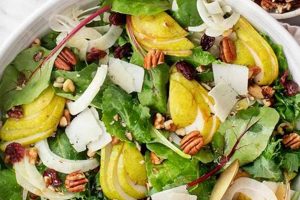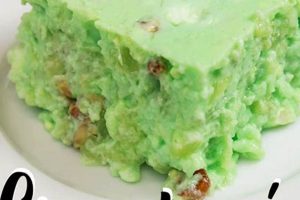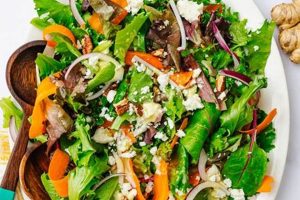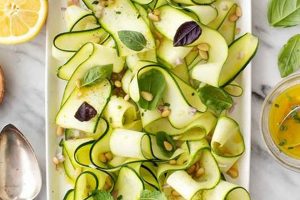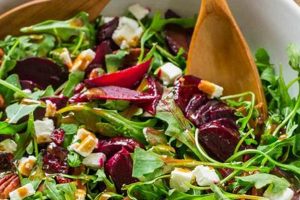An antipasto salad combines cured meats, cheeses, vegetables, olives, and marinated items, typically served as a first course or appetizer. A well-composed version offers a diverse range of flavors and textures, from salty prosciutto and tangy pepperoncini to creamy mozzarella and crisp vegetables. It can be presented simply on a platter or more elaborately arranged, often with a vinaigrette-based dressing.
This style of salad provides a vibrant and flavorful beginning to a meal, stimulating the appetite and offering a preview of the flavors to come. Its customizable nature allows for endless variations, accommodating dietary preferences and seasonal ingredients. Historically rooted in Italian culinary tradition, it serves as a celebration of fresh, high-quality ingredients. The balance of flavors and textures offers not only a delicious experience but also a visually appealing presentation.
This article will explore variations on this classic appetizer, considering different regional influences, dietary adaptations, and presentation techniques. Further topics will include ingredient selection, dressing options, and suggested pairings with wines and other beverages.
Tips for Creating a Delicious Antipasto Salad
Crafting an exceptional antipasto salad involves careful consideration of ingredients, balance, and presentation. The following tips offer guidance for assembling a visually appealing and flavorful appetizer.
Tip 1: Quality Ingredients are Key: Opt for high-quality cured meats, cheeses, and olives. Fresh, seasonal vegetables are also essential for optimal flavor and texture.
Tip 2: Balance Flavors and Textures: Incorporate a variety of salty, tangy, and savory elements. Consider contrasting textures, such as crunchy vegetables, creamy cheeses, and chewy meats.
Tip 3: Consider Color and Arrangement: A visually appealing presentation enhances the dining experience. Arrange ingredients thoughtfully, incorporating a variety of colors and heights.
Tip 4: Dress Lightly: A simple vinaigrette complements the flavors of the ingredients without overpowering them. Avoid heavy, creamy dressings that can mask delicate flavors.
Tip 5: Marinate Vegetables for Enhanced Flavor: Marinating vegetables like artichoke hearts, mushrooms, or roasted peppers adds depth and complexity.
Tip 6: Don’t Overcrowd the Platter: Allow space between ingredients for easy serving and visual appeal. Overcrowding can make the salad appear less appetizing.
Tip 7: Serve at Room Temperature: Allow the ingredients to come to room temperature before serving to enhance their flavors and aromas.
By following these tips, one can create an antipasto salad that is not only delicious but also visually stunning, offering a memorable start to any meal.
This exploration of tips and techniques provides a foundation for crafting exceptional antipasto salads. The following section will delve into specific recipe ideas and variations.
1. Fresh, High-Quality Ingredients
The success of an antipasto salad hinges directly on the quality of its ingredients. Freshness is paramount, as the dish relies on the vibrant flavors of individual components. High-quality cured meats, such as prosciutto and salami, contribute a depth of flavor and satisfying texture that lower-grade alternatives cannot replicate. Similarly, cheeses like fresh mozzarella or aged provolone offer distinct flavor profiles that are lost when using processed substitutes. The brightness and acidity of marinated vegetables, whether artichoke hearts, roasted peppers, or marinated mushrooms, are also crucial. These elements depend on the quality of the produce itself and the careful balance of the marinade. Even the olives should be considered; plump, flavorful varieties like Castelvetrano or Kalamata elevate the salad significantly more than canned, generic options.
Consider the difference between using ripe, in-season tomatoes bursting with flavor versus pale, out-of-season tomatoes lacking sweetness. The same principle applies to every ingredient. Fresh basil leaves offer a vibrant aroma and peppery flavor that dried basil cannot match. High-quality olive oil provides a nuanced fruitiness and subtle bitterness that enhances the vinaigrette. By prioritizing fresh, top-tier ingredients, one ensures a complex and balanced flavor profile that distinguishes an exceptional antipasto salad from a mediocre one.
The emphasis on ingredient quality is not merely a culinary preference; it directly impacts the overall sensory experience. Subpar ingredients can result in a bland, uninspired salad, while fresh, high-quality components contribute to a vibrant, flavorful, and visually appealing dish. This understanding of ingredient importance allows for informed choices, leading to a more satisfying and enjoyable culinary experience.
2. Variety of Cured Meats
The inclusion of a variety of cured meats is essential for a well-balanced and flavorful antipasto salad. Different cured meats offer unique textures and flavor profiles, contributing complexity and depth to the overall composition. This variety not only enhances the sensory experience but also offers nutritional diversity. The following facets explore the role and impact of cured meat selection in an antipasto salad.
- Flavor Profiles:
Different cured meats contribute distinct flavors. Salami, for instance, often features robust garlic and spice notes, while prosciutto offers a delicate, salty sweetness. Sopressata delivers a peppery kick, and mortadella contributes a subtle, almost creamy flavor. This variety allows for a dynamic interplay of tastes, preventing the salad from becoming monotonous.
- Textural Variation:
Cured meats provide textural contrast within the salad. Hard salami offers a firm, chewy bite, while prosciutto provides a delicate, almost melt-in-your-mouth texture. ‘Nduja, a spreadable salami, introduces a creamy element. These varying textures interact with the other components of the salad, creating a more engaging culinary experience.
- Regional Influences:
The selection of cured meats can reflect regional Italian culinary traditions. Southern Italian antipasto might feature spicy Calabrian soppressata, while a Tuscan version might include finocchiona, flavored with fennel seeds. Exploring regional variations allows for a deeper appreciation of Italian culinary diversity.
- Nutritional Considerations:
While cured meats are generally high in sodium and fat, choosing leaner options like prosciutto or bresaola and consuming them in moderation can mitigate these concerns. Furthermore, cured meats offer a source of protein and certain vitamins and minerals.
The careful selection of cured meats elevates the antipasto salad beyond a simple appetizer to a complex and nuanced culinary experience. By considering the interplay of flavors, textures, regional influences, and nutritional aspects, one can create a truly exceptional and memorable dish. This understanding of the role of cured meats underscores their importance in the overall composition and balance of a successful antipasto salad.
3. Assortment of Cheeses
An assortment of cheeses plays a crucial role in a successful antipasto salad recipe, contributing significantly to its flavor profile, texture, and overall appeal. Cheese selection impacts not only the immediate sensory experience but also the balance and harmony of the dish as a whole. The interplay between different cheese varieties creates a dynamic range of flavors and textures, elevating the salad beyond a simple combination of ingredients.
Different cheese types offer unique characteristics that enhance the complexity of the salad. Hard cheeses like Parmesan or Pecorino Romano provide a sharp, salty bite, while softer cheeses like mozzarella offer a creamy, milky contrast. Semi-hard cheeses such as provolone or fontina contribute a smooth, nutty flavor, and crumbly cheeses like feta or gorgonzola introduce tangy or pungent notes. This variety ensures a balanced flavor profile, preventing the salad from becoming one-dimensional. For instance, the saltiness of Parmesan can balance the sweetness of roasted red peppers, while the creaminess of mozzarella complements the saltiness of cured meats. Furthermore, the textures of different cheeses interact with the other components of the salad. The firm bite of Parmesan contrasts with the soft texture of marinated artichoke hearts, while the creamy mozzarella offsets the crispness of fresh vegetables.
Understanding the role of cheese variety in an antipasto salad allows for informed choices that enhance the overall dining experience. Consider a salad featuring only mozzarella. While mozzarella is delicious, the salad would lack the complexity and depth of flavor that a combination of mozzarella, Parmesan, and gorgonzola could offer. Similarly, using only hard cheeses might result in a salad that is too sharp and lacks textural diversity. The strategic selection of an assortment of cheeses is essential for achieving a balanced and harmonious antipasto salad. This understanding translates into a more nuanced appreciation of the dish, highlighting the importance of each component in contributing to the overall culinary experience.
4. Marinated Vegetables
Marinated vegetables are a crucial component of a successful antipasto salad, providing a bright, acidic counterpoint to the richness of cured meats and cheeses. Their presence not only adds depth of flavor but also introduces a vibrant color palette and textural variety. Careful selection and preparation of marinated vegetables significantly enhance the overall balance and complexity of the salad.
- Flavor Enhancement:
Marinades infuse vegetables with complex flavors, moving beyond their natural taste profile. A simple marinade of olive oil, vinegar, garlic, and herbs can transform bland vegetables into vibrant, flavorful components. For example, artichoke hearts, often mild on their own, absorb the marinade, becoming tangy and savory. This amplified flavor contributes to the overall balance of the antipasto salad, preventing it from becoming overly rich or heavy.
- Textural Contrast:
The marinating process can also influence the texture of vegetables. Mushrooms, for instance, develop a pleasant chewiness when marinated, while bell peppers retain their crispness. This textural variation adds another layer of interest to the antipasto salad, complementing the smoothness of cheeses and the chewiness of cured meats.
- Visual Appeal:
Marinated vegetables contribute significantly to the visual appeal of the salad. Roasted red peppers offer a vibrant splash of color, while marinated artichoke hearts provide an interesting textural element. The variety of colors and shapes enhances the overall presentation, making the salad more visually engaging.
- Balancing Acidity:
The acidity introduced by marinated vegetables is crucial for balancing the richness of the other components. The tanginess of marinated mushrooms, for instance, cuts through the fattiness of salami, creating a more harmonious and balanced flavor profile. This acidity also stimulates the appetite, making the antipasto salad a refreshing and enticing start to a meal.
The strategic inclusion of marinated vegetables elevates the antipasto salad from a simple assortment of ingredients to a carefully composed dish where each element contributes to the overall harmony and balance. The interplay of flavors, textures, and colors provided by marinated vegetables is essential for creating a truly exceptional and memorable antipasto salad experience.
5. Complementary Olives
Olives contribute a crucial briny, salty, and sometimes bitter element to an antipasto salad, acting as a foil to the richness of cheeses and cured meats. Their inclusion is not merely a matter of tradition but a deliberate choice that enhances the complexity and balance of flavors. The specific type of olive selected influences the overall taste profile. For instance, Castelvetrano olives offer a mild, buttery flavor, while Kalamata olives provide a more assertive, briny taste. Cerignola olives, with their large size and meaty texture, contribute a substantial saltiness. The choice of olive should complement the other ingredients; a delicate olive might be overwhelmed by strong flavors, while an intensely briny olive might clash with milder components. This careful selection ensures that the olives enhance, rather than detract from, the overall harmony of the salad.
Consider an antipasto salad featuring spicy soppressata, sharp provolone, and peppery arugula. Castelvetrano olives, with their mild flavor, might be overshadowed by the other bold ingredients. In this case, Kalamata olives, with their robust brininess, would provide a more effective counterpoint, cutting through the spice and richness of the other components. Conversely, in a salad featuring fresh mozzarella, prosciutto, and roasted red peppers, the intense saltiness of Cerignola olives might overpower the more delicate flavors. Castelvetrano or Gaeta olives, with their milder profiles, would be more complementary in this context. These examples illustrate the practical significance of selecting olives that complement the other ingredients, showcasing the interplay of flavors and the importance of balance.
The successful integration of olives into an antipasto salad requires an understanding of their flavor profiles and how they interact with other ingredients. This knowledge allows for informed decisions that enhance the overall culinary experience, demonstrating that the inclusion of olives is not merely a matter of following tradition but a deliberate act of culinary artistry. Choosing complementary olives ensures a harmonious balance of flavors, elevating the antipasto salad from a simple collection of ingredients to a cohesive and nuanced dish. This understanding is crucial for achieving the desired complexity and balance that defines a well-composed antipasto salad.
6. Crisp Breads or Crackers
Crisp breads or crackers play a significant role in the overall composition and enjoyment of an antipasto salad. Their presence offers not only a textural counterpoint to the other ingredients but also a practical means of conveying the flavors of the salad. The inclusion of these elements elevates the dining experience, transforming the antipasto salad from a collection of separate components into a cohesive and interactive culinary creation.
The textural contrast provided by crisp breads or crackers is paramount. The crunchy texture offsets the soft, creamy cheeses, the chewy meats, and the tender marinated vegetables. This interplay of textures creates a more dynamic and engaging sensory experience. Imagine biting into a piece of crostini topped with creamy gorgonzola, salty prosciutto, and a sliver of sweet fig. The crunch of the crostini provides a satisfying contrast to the other textures, enhancing the overall enjoyment. Furthermore, the crisp breads or crackers act as a vehicle for the other ingredients. They provide a convenient and elegant way to enjoy the combination of flavors. Scooping up a mixture of marinated artichoke hearts, olives, and a dollop of ‘nduja with a piece of focaccia allows for a harmonious blend of tastes in each bite. This practical function enhances the ease and pleasure of consuming the salad, transforming it into a more interactive experience.
The strategic incorporation of crisp breads or crackers demonstrates a sophisticated understanding of texture and flavor interplay within the antipasto salad. This seemingly simple addition elevates the dish, transforming it into a more complex and satisfying culinary experience. The textural contrast and functional role of crisp breads or crackers underscore their importance as an integral component of a well-composed antipasto salad. Their inclusion is not merely an afterthought but a deliberate choice that contributes significantly to the overall balance and enjoyment of the dish. Neglecting this element diminishes the potential for a truly exceptional and memorable antipasto experience.
7. Balanced Vinaigrette
A balanced vinaigrette is essential for a successful antipasto salad, providing a unifying element that complements and enhances the diverse flavors of the individual components. The vinaigrette acts as a bridge, connecting the distinct tastes of cured meats, cheeses, olives, and marinated vegetables, creating a harmonious whole. Its function extends beyond simply adding moisture; it contributes acidity, sweetness, and herbaceous notes that balance the richness and saltiness of the other ingredients. A poorly constructed vinaigrette, whether too acidic, too sweet, or lacking in flavor, can disrupt this delicate balance, detracting from the overall enjoyment of the salad. The vinaigrette should enhance, not mask, the flavors of the other components. For instance, a vinaigrette with a high proportion of vinegar can overpower the delicate flavor of fresh mozzarella, while a cloyingly sweet dressing might clash with the salty tang of cured meats.
Consider a classic lemon-herb vinaigrette. The bright acidity of the lemon juice cuts through the richness of the cheeses and meats, while the fresh herbs, such as oregano or basil, complement the savory notes of the olives and marinated vegetables. A touch of sweetness, perhaps from a small amount of honey or maple syrup, balances the acidity and adds depth of flavor. The quality of the olive oil used in the vinaigrette is also crucial. A high-quality extra virgin olive oil contributes fruity and peppery notes that enhance the overall complexity of the dressing. The balance of these elements acidity, sweetness, herbaceousness, and the quality of the oil is paramount. Even a slight imbalance can affect the overall taste profile of the salad. Too much acidity can make the salad sharp and unpleasantly tart, while insufficient acidity can leave it tasting flat and greasy. A well-balanced vinaigrette, on the other hand, enhances the flavors of the individual ingredients, creating a harmonious and delicious culinary experience.
The significance of a balanced vinaigrette in an antipasto salad recipe extends beyond mere flavor enhancement. It reflects a thoughtful approach to culinary composition, demonstrating an understanding of how different flavors interact and complement each other. The careful balance of acidity, sweetness, and herbaceous notes elevates the antipasto salad from a simple collection of ingredients to a cohesive and nuanced dish. This attention to detail is crucial for achieving the desired harmony and balance that characterizes a truly exceptional antipasto salad. Mastering the art of the balanced vinaigrette is essential for anyone seeking to create this classic dish, ensuring a delightful and memorable culinary experience.
Frequently Asked Questions
This section addresses common inquiries regarding the preparation and enjoyment of antipasto salads, offering practical guidance for achieving optimal results.
Question 1: What is the ideal serving temperature for antipasto salad?
Serving antipasto salad at room temperature allows the flavors of the cured meats, cheeses, and marinated vegetables to fully develop. Chilling the salad can mute these flavors and make the textures less appealing.
Question 2: Can antipasto salad be prepared in advance?
While some components can be prepared ahead of time, assembling the salad too far in advance can lead to soggy vegetables and less appealing textures. It is generally recommended to assemble the salad shortly before serving.
Question 3: How long can antipasto salad be stored?
Leftover antipasto salad can be stored in an airtight container in the refrigerator for up to two days. However, the quality and texture may deteriorate over time.
Question 4: What type of dressing is best suited for antipasto salad?
A light, vinaigrette-based dressing is typically preferred for antipasto salad, as it complements the flavors of the ingredients without overpowering them. Heavy, creamy dressings are generally not recommended.
Question 5: Can antipasto salad be adapted for vegetarian diets?
Absolutely. Omitting the cured meats and focusing on a variety of cheeses, marinated vegetables, olives, and other plant-based components creates a delicious and satisfying vegetarian antipasto salad.
Question 6: What beverages pair well with antipasto salad?
A crisp, dry white wine, such as Pinot Grigio or Sauvignon Blanc, complements the flavors of antipasto salad. Light-bodied red wines, like Chianti, are also suitable pairings.
Addressing these frequently asked questions provides a deeper understanding of the nuances of antipasto salad preparation and enjoyment. These insights facilitate informed choices, ensuring a more successful and satisfying culinary experience.
The following section will explore variations on the classic antipasto salad recipe, incorporating diverse regional influences and culinary preferences.
Crafting the Perfect Antipasto Salad
Exploration of antipasto salad recipes reveals the importance of fresh, high-quality ingredients and the careful balance of flavors, textures, and colors. From the selection of cured meats and cheeses to the inclusion of marinated vegetables, olives, and crisp breads, each component contributes to the overall harmony and complexity of the dish. A well-balanced vinaigrette further enhances the flavors, unifying the diverse elements into a cohesive culinary experience. Understanding the interplay of these components is crucial for achieving a truly exceptional antipasto salad.
The enduring appeal of antipasto salad lies in its adaptability and capacity to showcase fresh, seasonal ingredients. Continued exploration of regional variations and innovative ingredient combinations promises to further elevate this classic dish, offering endless possibilities for culinary creativity and enjoyment. Ultimately, the pursuit of the perfect antipasto salad represents a celebration of fresh, flavorful ingredients and the art of balanced culinary composition.

